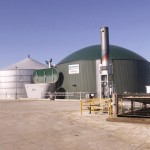After the Fukushima accident Germany has committed to the ambitious target of decommissioning all its nuclear plants by 2022 and has accelerated its plan of achieving a 50% share of renewable energy in electricity production by 2021. In accordance with this political trend the Bavarian government has published an energy concept in 2011 with a target of 50% renewable electricity by 2021, mainly based on a massive increase of non predictable and volatile sources such as photovoltaic and wind energy.
Flexible generation biogas plants to help covering the residual load
The problem with the use of unpredictable renewable energy sources is that in peak periods they can lead to overproduction (i.e. in summer midday for PV) while in most other periods they cannot meet the demand throughout the year. Since storage of renewable energy is not economically viable at this point in time, high-efficiency conventional gas-fired power plants must be used to help fill residual load, however these plants cannot always be run economically due to the high price of natural gas compared to cheaper coal. In order to address this problem an innovative concept was elaborated by the Bavarian Ministry of Food Agriculture and Forestry, which is focused on the flexible generation of power from the numerous biogas plants operating in the region.
In 2012, around 2,300 biogas plants with an electrical power of 702 MW were installed in Bavaria, covering around 6% of total annual electricity demand for the region. These plants are fed with agricultural feedstock raw material and organic waste and run as base load power stations in rural areas. Society is hesitant about the introduction of new agricultural biogas plants but an additional use of organic waste and slurry would be more accepted. It is on this premise that the BayernPlan was born.
The main goal of the plan is to use existing biogas-power plants to cover the increasing residual load in Bavaria, by pooling together smaller biogas plants to operate as a larger virtual power plant and focus on the whole energy supply system rather than just the grids in rural areas. Using this approach biogas energy could be used on demand to fill a proportion of the residual load when solar and wind does not suffice, and thus biogas could begin to replace the amount of fossil fuel energy used.The main innovation in this approach is the shifting of biogas plants from a base load to a flexible load operation mode, so that plants can produce electricity at high power output at certain times during the day and remain idle during other times. To achieve this, the produced biogas must be stored in gasometers until it is used for electricity.
Additional biogas storage capacity is required
At this moment in time, only 20% of existing plants in Bavaria have the substantial potential to store biogas. The rest of the plants do not have enough storage for the required operating mode. This means that further storage capacity should be installed to achieve the goal of the BayernPlan. Less than 10% of the plants have more than one electric power station. New systems should be installed with more power or parallel multiple generating systems. Further adaption would be also required for the grid system.
The extra costs necessary for these technical adjustments were assessed in a range from 0.33cent/kWhel to 2.83cent/kWhel. The additional rated power of biogas plants operating in flexible mode was assessed at 450 MW whereas the electricity demand oscillates between 4 and 7GW most time of the year. Therefore this innovative concept could provide a sensible contribution to the stabilization of the load and the achievement of the BayernPlan, although at present only two plants in Bavaria will be modified to be able for the new operation mode, and laws and regulations will have to be adapted to facilitate the repowering and the installation of new storage capacity.
This post is based on a paper by M. Schmidt et. al. – Bavarian Ministry of Food Agriculture and Forestry, presented at the 21st European Biomass Conference and Exhibition. Download the full paper here



